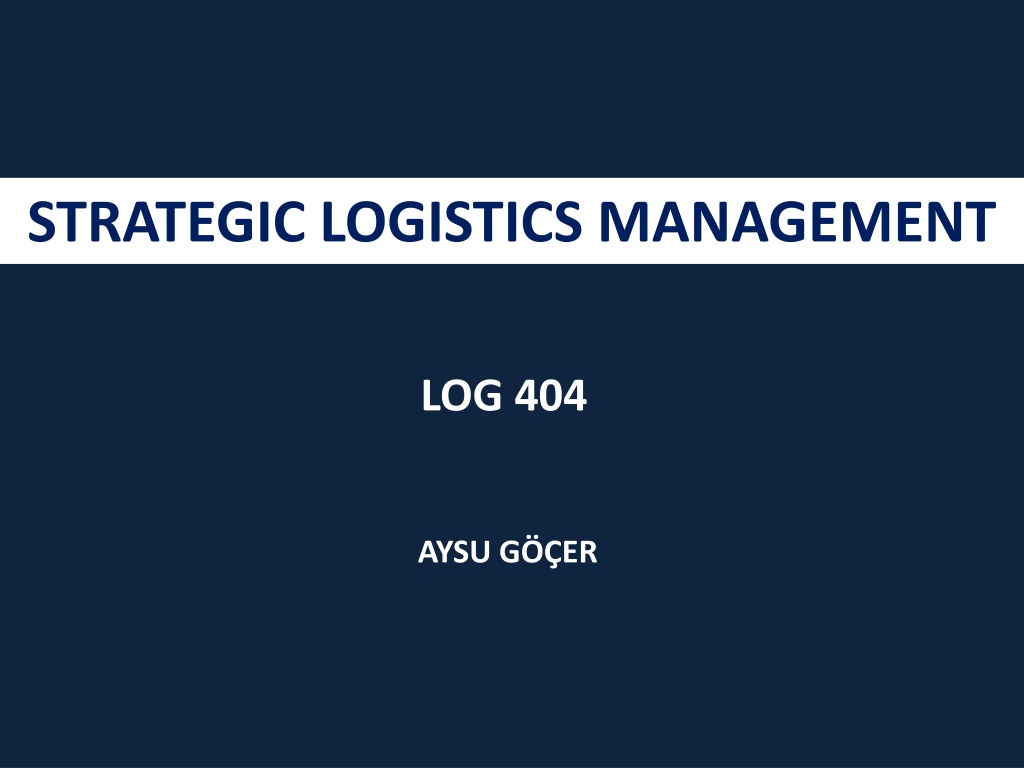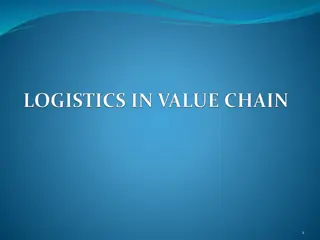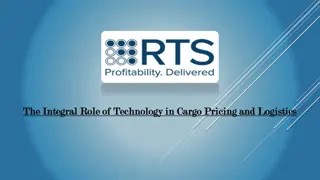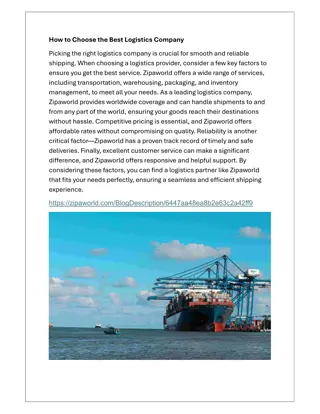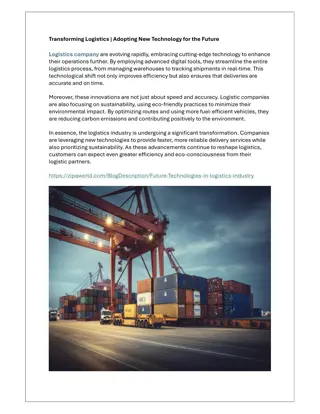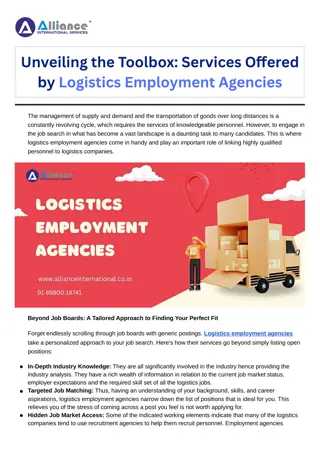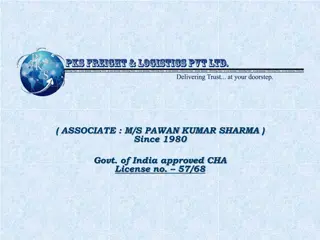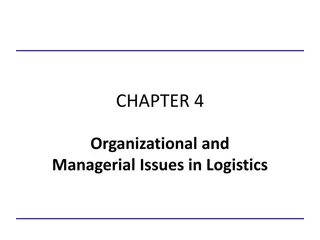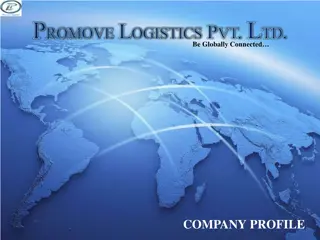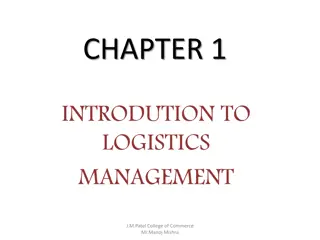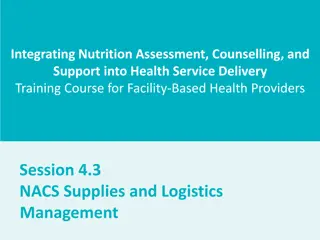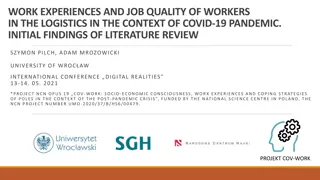STRATEGIC LOGISTICS MANAGEMENT
Customer Relationship Management is a business philosophy focusing on building customer loyalty and extracting additional value. E-business developments offer opportunities for better supply chain management through collaborative planning, production synchronization, joint product development, logistics planning, e-procurement, and more. Develop loyalty through trust and identify profitable customer segments. Niche markets in online logistics providers and freight transportation industry cater well to e-commerce, with significant economies of scale and emerging models.
Download Presentation

Please find below an Image/Link to download the presentation.
The content on the website is provided AS IS for your information and personal use only. It may not be sold, licensed, or shared on other websites without obtaining consent from the author.If you encounter any issues during the download, it is possible that the publisher has removed the file from their server.
You are allowed to download the files provided on this website for personal or commercial use, subject to the condition that they are used lawfully. All files are the property of their respective owners.
The content on the website is provided AS IS for your information and personal use only. It may not be sold, licensed, or shared on other websites without obtaining consent from the author.
E N D
Presentation Transcript
STRATEGIC LOGISTICS MANAGEMENT LOG 404 AYSU G ER
COMPETITIVENESS STRATEGIES IN SCM IMPACT OF E-BUSINESS DEVELOPMENTS ON SUPPLY CHAIN STRATEGIES B2B B2C e-Supply Chain Opportunities Areas of which e-business developments facilitated opportunities for better SCM; Collaborative demand planning Syncronized production planning Joint product development Better logistics planning e-Procurement Auctions / reverse auctions e-Marketplaces Bar coding and EDI Intranets / extranets and VPNs
COMPETITIVENESS STRATEGIES IN SCM IMPACT OF E-BUSINESS DEVELOPMENTS ON SUPPLY CHAIN STRATEGIES CUSTOMER RELATIONSHIP MANAGEMENT is a business philosophy, a set of strategies, programmes and enabling systems that focus upon identifying and building customer loyalty with the prime objective being to squeeze additional value from higher spenders the retailer s most valued customers To match a product or a service with the needs of the customer (creating a single cohesive view of the customer) Data warehouses / Data mining Used to develop sales, build long term relationship Makes mass customization a reality How customers interact with the organization? What they purchase? How often they purchase? When they purchase? How they pay? DEVELOP LOYALTY THROUGH TRUST AND IDENTIFY PROFITABLE CUSTOMER SEGMENTS !!!
COMPETITIVENESS STRATEGIES IN SCM Niche Markets - Online Logistics Providers The Freight Transportation Industry is Ideally Suited e-commerce High Fragmentation of Shippers and Carriers Many Intermediaries Complex Supply Chains High Search Costs Significant Opportunities for Economies of Scale Several Models Emerging
COMPETITIVENESS STRATEGIES IN SCM Niche Markets - Online Logistics Providers Online Freight Marketplaces Spot market Auction and RFQ Exchange Meta-marketplaces Application Service Providers (ASPs) Purchasing Consolidation Market Infomediaries
COMPETITIVENESS STRATEGIES IN SCM Niche Markets - Online Logistics Providers SPOT MARKET Cash market Goods are sold in cash and delivered immediately Players: individuals, industry organizations and governments, speculators Energy spot market Natural gas market in Europe: Title Transfer Facility in Netherlands, National Balancing Point in UK
COMPETITIVENESS STRATEGIES IN SCM Niche Markets - Online Logistics Providers REQUEST FOR QUOTATION A request for quotation (RFQ) is a standard business process whose purpose is to invite suppliers into a bidding process to bid on specific products or services. An RFQ typically involves more than the price per item. Information like payment terms, quality level per item or contract length are possible to be requested during the bidding process. The suppliers have to return the bidding by a set date and time to be considered for an award. Discussions may be held on the bids. The bid does not have to mean the end of the bidding. Multiple rounds can follow or even a Reverse auction can follow to generate the best market price. RFQ's are best suited to products and services that are as standardized and as commoditized as possible, as this makes each suppliers quotes comparable. An RFQ allows different contractors to provide a quotation, among which the best will be selected
COMPETITIVENESS STRATEGIES IN SCM Niche Markets - Online Logistics Providers EXCHANGE
COMPETITIVENESS STRATEGIES IN SCM Niche Markets - Online Logistics Providers META MARKETPLACES Meta Market is a web-based market centered around an event or an industry, rather than a single product. The web allows to match producers' desire for economies of scale, and consumers' desire for variety of choice to satisfy a set of needs. Meta market for an entire industry (for example chemical industry) where the industry can trade excess inventory, source new suppliers and find new vendors.
COMPETITIVENESS STRATEGIES IN SCM Niche Markets - Online Logistics Providers APPLICATION SERVICE PROVIDERS (ASP) An application service provider (ASP) is a business that provides computer-based services to customers over a network. Software offered using an ASP model is also sometimes called On- demand software or software as a service (SaaS). The need for ASPs has evolved from the increasing costs of specialized software that have far exceeded the price range of small to medium sized businesses. up-to-date services, 24 x 7 technical support, physical and electronic security
COMPETITIVENESS STRATEGIES IN SCM Niche Markets - Online Logistics Providers PURCHASING CONSOLIDATION MARKET
COMPETITIVENESS STRATEGIES IN SCM Niche Markets - Online Logistics Providers INFOMEDIARIES
COMPETITIVENESS STRATEGIES IN SCM ORDER QUALIFIER AND ORDER WINNER Terry Hill argues that the criteria required in the marketplace can be divided into two groups: order qualifiers and order winners. An order qualifier is a characteristic of a product or service that is required in order for the product/service to even be considered by a customer. An order winner is a characteristic that will win the bid or customer's purchase. To provide qualifiers, they need only to be as good as their competitors. Failure to do so may result in lost sales. However, to provide order winners, firms must be better than their competitors. It is important to note that order qualifiers are not less important than order winners; they are just different. Firms must also exercise some caution when making decisions based on order winners and qualifiers.
COMPETITIVENESS STRATEGIES IN SCM ORDER QUALIFIER AND ORDER WINNER A firm producing a high quality product (where high quality is the order-winning criteria). If the cost of producing at such a high level of quality forces the cost of the product to exceed a certain price level (which is an order-qualifying criteria), the end result may be lost sales, thereby making "quality" an order- losing attribute. Order winners and qualifiers are both market-specific and time-specific. They work in different combinations in different ways on different markets and with different customers. While, some general trends exist across markets, these may not be stable over time. For example, in the late 1990s delivery speed and product customization were frequent order winners, while product quality and price, which previously were frequent order winners, tended to be order qualifiers.
COMPETITIVENESS STRATEGIES IN SCM ORDER QUALIFIER AND ORDER WINNER Also, since customers' stated needs do not always reflect their buying habits, Hill recommends that firms study how customers behave, not what they say. When a firm's perception of order winners and qualifiers matches the customer's perception of the same, there exists a "fit" between the two perspectives. A substantial gap exists between managers' and customers' opinions on why they did business together- favorable sales performance resulted when there was a good fit between a firm's perception of the strengths of a product and customer perception of the product.
COMPETITIVENESS STRATEGIES IN SCM ORDER QUALIFIER AND ORDER WINNER 5 key performance areas
COMPETITIVENESS STRATEGIES IN SCM ORDER QUALIFIER AND ORDER WINNER
COMPETITIVENESS STRATEGIES IN SCM ORDER QUALIFIER AND ORDER WINNER
COMPETITIVENESS STRATEGIES IN SCM ORDER QUALIFIER AND ORDER WINNER Different logistics performance objectives Order winners are factors that directly and significantly help products to win orders in the marketplace. Customers regard such factors as key reasons for buying that product or services. Order qualifiers are factors that are regarded by the market as an entry ticket . Unless the product or service meets basic performance standards, it will not be taken seriously.
COMPETITIVENESS STRATEGIES IN SCM ORDER QUALIFIER AND ORDER WINNER BENCHMARK to measure; Order cycle times Delivery reliability Frequency of delivery Stock availability Documentation quality Order completeness Technical support
COMPETITIVENESS STRATEGIES IN SCM SCOR MODEL Process Reference Model Standard description of management processes Framework of relations among standard processes Standard metrics to measure process performance Standard alignment to software functions and features
COMPETITIVENESS STRATEGIES IN SCM SCOR MODEL In SCM, Operational and Design side clear BUT Strategic side is MISSING . So, SCOR Model is to achieve a better STRATEGIC decision making !!!
COMPETITIVENESS STRATEGIES IN SCM SCOR MODEL SCOR links Process Elements Process Metrics Best Practice Technology Cross Processes & Vertical View
COMPETITIVENESS STRATEGIES IN SCM SCOR MODEL SCOR allows *Companies to communicate using common technology *Standard description of process elements *Best practices yielding optimal overall performance
COMPETITIVENESS STRATEGIES IN SCM SCOR MODEL SCOR integrates concepts into a cross-functional framework Re-engineering Benchmarking Process Measurement
COMPETITIVENESS STRATEGIES IN SCM SCOR MODEL SCOR captures AS IS SCOR derives TO BE
COMPETITIVENESS STRATEGIES IN SCM SCOR MODEL 5 Management Processes of SCOR Model Plan (demand and supply planning) Source (procurement) Make (production) Deliver (to the customer) Return (reverse flow)
COMPETITIVENESS STRATEGIES IN SCM SCOR MODEL The SCOR Model (Source: : http://www.supply-chain.org)
COMPETITIVENESS STRATEGIES IN SCM SCOR MODEL (PROCESS LEVELS)
COMPETITIVENESS STRATEGIES IN SCM SCOR MODEL (PROCESS LEVELS) SCOR model level I performance metrics Delivery reliability Delivery performance Fill rates Perfect order fulfillment Responsiveness Order fulfillment lead times Flexibility Supply chain response time Production flexibility Cost Cost of goods sold Total supply chain management cost Value-added employee productivity Warranty/return processing costs Assets Cash-to-cash cycle time Inventory days of supply Asset turns
COMPETITIVENESS STRATEGIES IN SCM SCOR MODEL BENEFITS OF SCOR MODEL Cost Reduction and Customer Service Improvement ROI (improvement) ROA (improvement) Use of Standard features of Information Technology Systems Profit due to improvements in Supply Chain Management
COMPETITIVENESS STRATEGIES IN SCM SUPPLY CHAIN MANAGEMENT MATURITY MODEL Supply Chain Management Maturity Model (Source: Lockamy/McCormack 2004)
COMPETITIVENESS STRATEGIES IN SCM CLASS WORKSHOP IV Compare the details for characteristics of both household appliance and mobile phone s product lines Vs. Go on to identify the principal order winners and qualifiers for each product
COMPETITIVENESS STRATEGIES IN SCM LEVELS OF IMPLIED DEMAND UNCERTAINTY Detergent High Fashion Customer Need Price Responsiveness Low High Implied Demand Uncertainty
COMPETITIVENESS STRATEGIES IN SCM Different product ranges have different logistics performance objectives
COMPETITIVENESS STRATEGIES IN SCM PORTFOLIO ANALYSIS FOR COMPETITIVENESS: BOSTON CONSULTING GROUP APPROACH BCG MATRIX Relative Market Share High Low Stars Question Marks ? Low High Market Growth Rate High growth & share Profit potential May need heavy investment to grow High growth, low share Build into Stars or phase out Require cash to hold market share Dogs Cash Cows Low growth & share Low profit potential Low growth, high share Established, successful SBU s Produce cash
COMPETITIVENESS STRATEGIES IN SCM POWER STRATEGIES WHEN CUSTOMERS ARE DOMINANT Purchasing, co-ordination: combining volumes Multiple sourcing Competitive bidding Cost down programmes opencost or openbook costing Consortium buying POWER STRATEGIES WHEN SUPPLIERS ARE DOMINANT Technological innovation Value-added services Takeover customer tasks Offer technical support
COMPETITIVENESS STRATEGIES IN SCM MAKE OR BUY?? If an organization produces goods, it incurs the full cost of owning plant and manufacturing capacity It could choose to buy-in those goods from another supplier and dispose of assets, resources and competencies it owns The organization will need to carefully evaluate the risks in taking this course of action Make or buy decisions must ensure that the resources and competencies can be better applied elsewhere or disposed of if the organization stops making and buys in products instead
COMPETITIVENESS STRATEGIES IN SCM SUPPLY CHAIN PARTNERING Partnerships or co-operative relationships have some or all of the following attributes; Information sharing Trust Co-ordinated planning arrangements Shared risks Mutual benefits Recognition of independence Shared goals Integrated prosseses Shared culture, compatibility and understanding Open book accounting
COMPETITIVENESS STRATEGIES IN SCM SUPPLY CHAIN PARTNERING
COMPETITIVENESS STRATEGIES IN SCM SUPPLY CHAIN PARTNERING
